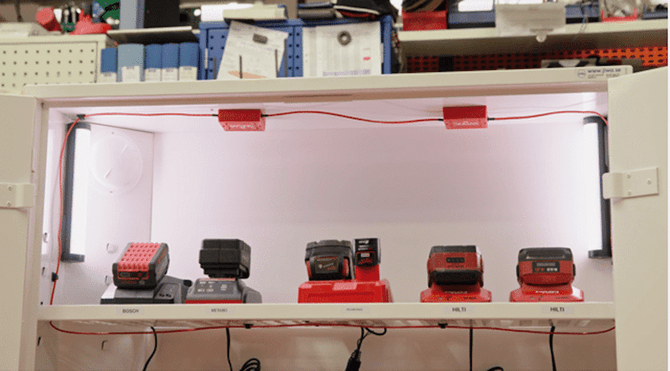Danger Flammable Sign - flammable sign
In addition to its fire-fighting capabilities, MAUS’s environmentally friendly and residue-free aerosol offers several other advantages:
20 Station Lithium-ionBattery Charging Cabinet

Poor Ventilation Charging cabinets that lack adequate ventilation can accumulate heat during the charging process. Batteries, especially lithium-ion types, generate heat while charging, and without proper ventilation, this heat can build up, increasing the risk of fire.

Fireproofbattery charging cabinet
Fires in charging cabinets for batteries can start due to several factors, typically related to the batteries themselves, the charging process, or the surrounding environment. To mitigate these risks, charging cabinets should be designed with adequate ventilation, proper temperature control and safety mechanisms such as overcharge protection.
Thermal runaway (extremely high temperature) and the fact that the batteries self-oxidize (literally producing their own oxygen) during thermal runaway This means that it is not enough to simply reduce the temperature temporarily or smother the fire; you must also prevent new thermal runaway and halt the oxidation process.
Physical Damage If batteries are physically damaged, either before or during charging, they can become unstable. Damage to the battery casing, internal components, or connections can lead to a short circuit, overheating, or leakage of flammable electrolytes, which can ignite.
lithium-ionbattery charging cabinet

Battery charging cabinetfor sale
Lead acidbattery charging cabinet
There are two key factors that make lithium battery fires particularly difficult to extinguish MAUS potassium-based aerosol achieves this through several parallel processes. By encapsulating the heat particles, the temperature is rapidly and effectively reduced to below the ignition point, thereby halting thermal runaway. Simultaneously, the highly active potassium radicals in the aerosol interact with the chemical combustion reactions and interrupt them by neutralizing hydrogen, oxygen, and hydroxide radicals in the flame, effectively stopping the oxidation process.
Improper Charging Equipment Using chargers that are not compatible with the battery’s specifications can cause excessive current or voltage, leading to overheating or other dangerous conditions. Non-certified or low-quality chargers are particularly risky.
Thermal Runway This is a critical failure mode for lithium-ion batteries. When one cell in a battery pack goes into thermal runaway, it can cause adjacent cells to heat up and also enter thermal runaway, creating a chain reaction that can lead to a fire.
Short Circuits Damaged or defective batteries can experience internal short circuits, which generate heat rapidly and can ignite the flammable materials within the battery. Short circuits can be caused by manufacturing defects, physical damage, or contamination inside the battery.
Reducing Reducing the risk of flammable and easily ignitable hydrogen gas (which can be produced when water reacts with lithium).
Battery charging cabinetaustralia
Environmental Factors Extreme temperatures, high humidity, or exposure to flammable materials inside the charging cabinet can increase the risk of fire. For example, charging batteries in a hot environment can exacerbate heating issues, leading to a fire.
Battery Defects Manufacturing defects in batteries, such as impurities or flaws in the materials, can lead to unexpected failures. For example, internal defects can cause a short circuit or trigger a chemical reaction that leads to overheating and fire.
Overcrowded Cabinets Storing too many batteries close together in a charging cabinet can prevent adequate cooling and increase the risk of a fire spreading if a single battery fails. Crowding can also lead to accidental short circuits.
As the aerosol remains in the space, it continues to cool and suppress any remaining hot gases, thereby preventing further thermal runaway or oxidation If reignition does occur, the remaining aerosol instantly reacts by encapsulating the heat particles again and halting the oxidation process. Thus, MAUS aerosol not only extinguishes the initial fire quickly and effectively but also prevents reignition very effectively.
Battery charging cabinetfor home
The MAUS Stixx PRO-series provides an additional layer of safety. In the event of a fire, the units automatically activate, dispersing a potassium-based suppressant within the charging cabinet to effectively extinguish lithium-ion battery fires and prevent the fire from spreading from the charging cabinet to the building.
Improper Storage Batteries stored in a fully charged state for extended periods can degrade, increasing the risk of failure during charging. Additionally, storing incompatible types of batteries together can also pose risks.
Overcharging If the charging system fails to properly regulate the voltage or current, it can lead to overcharging the batteries. Overcharging can cause the battery to overheat, which may result in thermal runaway—a condition where the battery heats up uncontrollably and can catch fire or explode.









 13322766566
13322766566